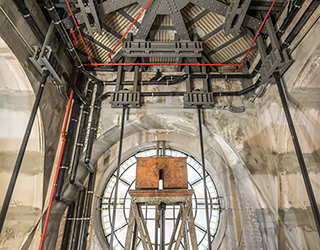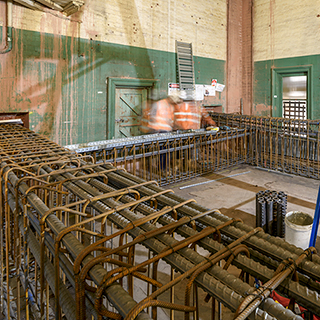Approach
All new buildings must comply with the Building Code of Australia (BCA) and various Australian Standards. However, seismic compliance for existing buildings is only usually triggered by the undertaking of repair, refurbishment or adaptation works — and even then, under certain conditions. Currently these conditions include a change of use, the addition of new structure, or repairs or refurbishment to a specified proportion of the building (for example, over 50% measured by volume), depending on its type.
The vulnerability of a structure to damage is influenced by a number of factors: how close the epicentre of an earthquake is to ground level, the duration of the event, the site and soil conditions, and the type of construction, condition and layout of the building. Of concern in older buildings are the dangers posed by such possibilities as weakened (or lack) of structural connections between roofs, walls, floors and footings, and materials degradation over time. Irregular floor plans, large spans or cantilevers and weak lateral walls also make a building more vulnerable. Non-structural features such as cornices and turrets may need to be secured.
Successful seismic strengthening in heritage contexts requires a combination of skilful engineering, an in-depth understanding of past building methods and materials, and the best available technologies. The aims are to reduce a building’s vulnerability, use methods that have minimal impact on the heritage integrity and fabric, and enable a building’s continued use.
If seismic strengthening is contemplated, an evaluation is carried out by an engineer. Where available, the original drawings for a building are consulted, although the emphasis is on examining the built form as it exists. Site visits are made to identify potential structural and non-structural deficiencies. Investigation of the footings might be carried out, and materials testing and analysis may be needed to ensure the actual rather than assumed inherent strength of the fabric is known.
A preliminary report is prepared based on the physical findings, along with consideration of the hazard level of the site, statutory aspects and building occupancy, use and operation. It may be that the building is structurally sound but considered unable to withstand seismic loading. Or it may potentially withstand seismic loading but require verification or improvements. On the other hand, it may not be practically possible to comply with the code and standards.
Whatever the situation, methods of intervention are put forward based on all the factors, including the level of seismic threshold loads determined to be appropriate by the regulations or the Relevant Building Surveyor (RBS). In the case of voluntary compliance, strengthening may form part of a programme of works, starting with the key elements that affect the safety of the users of the building.
The building code and standards provide for degrees of intervention based on defined categories. The appropriate level is determined through consideration of relevant factors, including heritage sensibility and the nature of the building and its fabric.
Milica Tumbas
top photo : Flinders Street Station by Martin Leitch
Case study


Seismic strengthening was a major component of the 2017/18 conservation works. Although structurally sound, the station was built in a period in which lateral walls played little part in a building’s overall strength or its ability to survive an earthquake. A second roof slab tied to the walls, steel mullions and rods fixed to and embedded in the masonry, and sections of extra reinforcing have been used to stiffen the fabric, and a post-tensioned assembly of steel rods, tie beams and a ring beam, plus reinforced concrete beams, used in the clock tower (pictured).
Engineer: Bonacci Group
photos : Martin Leitch

